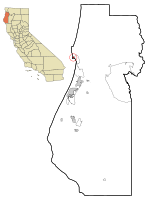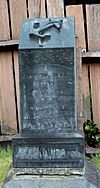Trinidad, California facts for kids
Quick facts for kids
Trinidad, California
|
|
|---|---|

A view of Trinidad from a trail on nearby Trinidad Head on May 27, 2006.
|
|

Location in Humboldt County and the state of California
|
|

A 2007 view of the coastline south of Trinidad overlooking Trinidad Bay with offshore rocks; part of the California Coastal National Monument.
|
|
| Country | |
| State | |
| County | Humboldt |
| Incorporated | November 7, 1870 |
| Government | |
| • Type | Council-Manager Government |
| Area | |
| • Total | 0.67 sq mi (1.74 km2) |
| • Land | 0.48 sq mi (1.26 km2) |
| • Water | 0.19 sq mi (0.48 km2) 27.75% |
| Elevation | 174 ft (53 m) |
| Population
(2020)
|
|
| • Total | 307 |
| • Density | 731.96/sq mi (282.68/km2) |
| Time zone | UTC-8 (Pacific (PST)) |
| • Summer (DST) | UTC-7 (PDT) |
| ZIP code |
95570
|
| Area code(s) | 707 |
| FIPS code | 06-80448 |
| GNIS feature IDs | 1660029, 2412093 |
| Reference #: | 216 |
Trinidad is a small city on the coast of California. Its name means "Trinity" in Spanish. The local Yurok people called it Chuerey. It is located in Humboldt County, right on the Pacific Ocean.
Trinidad is known for its beautiful coastline. It has ten public beaches and many offshore rocks. These rocks are part of the California Coastal National Monument. Fishing is very important here. It helps both local tourism and commercial fishing. Trinidad is one of California's smallest cities. In 2020, about 307 people lived there.
Contents
History of Trinidad
Early History and European Arrival
The Yurok people had a village called Tsurai in this area. They lived there for thousands of years. The village was located on cliffs overlooking Trinidad Bay. They left the village in 1916.
The first Europeans to see Trinidad Harbor were Spanish explorers. This happened in 1595. Later, in 1775, two Spanish ships anchored in Trinidad Bay. This was on June 9, 1775. On June 11, which was Trinity Sunday, the Spanish claimed the bay for their king. They named the area "La Santisima Trinidad" (The Most Holy Trinity). A stone cross was put up in 1913 where they first placed a wooden cross.
Changes in Control and American Settlement
The area was controlled by Spain until 1821. Then it became part of Mexico. Around 1806, Russian fur traders used Trinidad Bay. They hunted sea otters there. The United States took over California in 1846. California became a U.S. state in 1850.
American settlers arrived in Trinidad Bay in 1850. They founded the town. The first post office opened in 1851. Trinidad was the first county seat for Trinity County (1850-1851). It was also the county seat for Klamath County (1851-1854). In 1854, Trinidad became part of Humboldt County.
During the American Civil War (1861–1865), soldiers were stationed near Trinidad. They were there to protect the town. Trinidad officially became a city on November 7, 1870.
The Great Wave of 1914
On December 31, 1914, a huge ocean wave hit Trinidad Head. This was the largest wave ever recorded on the U.S. West Coast. A lighthouse keeper saw the wave coming. He reported that it looked like it reached the height of the lighthouse's lantern. The lantern was 196 feet (60 m) above sea level. The wave washed over a 93-foot-tall (28 m) rock. It then broke over the 175-foot-tall (53 m) cliff. Water reached the lighthouse's balcony. This suggests the wave might have been 200 feet (61 m) tall! The wave shook the lighthouse. It even put out its light for a short time.
Later Developments
A whaling station operated in Trinidad from 1920 to 1926. During that time, over 1,100 whales were caught.
A local resident, Henry A. Boyes, was a brave soldier. He served in the United States Marine Corps during World War II (1941–1945). His story was shared in a famous book.
In 1983, part of Trinidad Head became public land. It was meant for people to enjoy. In 2017, this area became part of the California Coastal National Monument. This means it is a special protected place.
Geography and Climate
Trinidad's Weather Patterns
Trinidad has a mild, oceanic climate. This means it has cool summers and mild winters. Temperatures usually range from about 37 to 74 °F (3 to 23 °C). Winter months get a lot of rain, about 50 inches (130 cm) per year. Even in summer, there can be some rain.
Fog is very common in Trinidad. It often rolls in from the ocean. This fog is important for the local Coast Redwood trees. These giant trees need the moisture from the fog to grow. You can visit protected redwood forests about 20 miles (32 km) north of Trinidad. They are in Redwood National and State Parks.
| Climate data for Trinidad, California | |||||||||||||
|---|---|---|---|---|---|---|---|---|---|---|---|---|---|
| Month | Jan | Feb | Mar | Apr | May | Jun | Jul | Aug | Sep | Oct | Nov | Dec | Year |
| Mean daily maximum °F (°C) | 53.6 (12.0) |
55.4 (13.0) |
58.0 (14.4) |
61.1 (16.2) |
65.3 (18.5) |
69.5 (20.8) |
73.7 (23.2) |
74.2 (23.4) |
72.5 (22.5) |
66.6 (19.2) |
57.3 (14.1) |
52.2 (11.2) |
63.3 (17.4) |
| Daily mean °F (°C) | 45.4 (7.4) |
46.6 (8.1) |
48.4 (9.1) |
50.8 (10.4) |
54.7 (12.6) |
58.6 (14.8) |
62.1 (16.7) |
62.4 (16.9) |
59.7 (15.4) |
54.9 (12.7) |
48.8 (9.3) |
44.7 (7.1) |
53.1 (11.7) |
| Mean daily minimum °F (°C) | 37.2 (2.9) |
37.7 (3.2) |
38.8 (3.8) |
40.4 (4.7) |
44.0 (6.7) |
47.6 (8.7) |
50.5 (10.3) |
50.4 (10.2) |
46.8 (8.2) |
43.1 (6.2) |
40.2 (4.6) |
37.1 (2.8) |
42.8 (6.0) |
| Average precipitation inches (mm) | 9.3 (240) |
7.7 (200) |
7.2 (180) |
4.5 (110) |
2.8 (71) |
1.3 (33) |
0.3 (7.6) |
0.4 (10) |
0.9 (23) |
3.2 (81) |
7.6 (190) |
10.6 (270) |
55.8 (1,415.6) |
| Average snowfall inches (cm) | 0.2 (0.51) |
0.6 (1.5) |
0.2 (0.51) |
0 (0) |
0 (0) |
0 (0) |
0 (0) |
0 (0) |
0 (0) |
0 (0) |
0 (0) |
0.4 (1.0) |
1.4 (3.52) |
| Average rainy days | 16.3 | 14.6 | 16.3 | 12.8 | 9.0 | 5.0 | 2.2 | 2.8 | 4.2 | 8.2 | 15.6 | 17.3 | 124.3 |
| Average snowy days | 0.2 | 0.3 | 0.2 | 0 | 0 | 0 | 0 | 0 | 0 | 0 | 0 | 0.3 | 1 |
Trinidad's Population and People
| Historical population | |||
|---|---|---|---|
| Census | Pop. | %± | |
| 1880 | 104 | — | |
| 1930 | 107 | — | |
| 1940 | 94 | −12.1% | |
| 1950 | 188 | 100.0% | |
| 1960 | 289 | 53.7% | |
| 1970 | 300 | 3.8% | |
| 1980 | 379 | 26.3% | |
| 1990 | 362 | −4.5% | |
| 2000 | 311 | −14.1% | |
| 2010 | 367 | 18.0% | |
| 2019 (est.) | 355 | −3.3% | |
| U.S. Decennial Census | |||

Who Lives in Trinidad?
The 2010 United States Census counted 367 people living in Trinidad. Most residents, about 90%, were White. There were also people of Native American, African American, Asian, and Pacific Islander backgrounds. About 3% of the population was Hispanic or Latino.
Almost everyone lived in homes. There were 187 households in total. About 19% of these homes had children under 18. Many households were married couples. Some were single-parent homes. About 39% of households had just one person living there. The average household had about two people.
The population includes people of all ages. About 16% were under 18. About 19% were 65 or older. The average age was around 46 years old. More people owned their homes (60%) than rented them (40%).
Places to Visit in Trinidad

Trinidad has many interesting places to see and explore:
- State Parks:
- Little River State Beach
- Sue-meg State Park
- Trinidad State Beach
- Historic Landmarks:
- Trinidad Head Light: A historic lighthouse.
- Trinidad Head: A famous rocky point.
- Town of Trinidad: The whole town is a historic landmark.
- Old Indian Village of Tsurai: The ancient Yurok village site.
- Other Fun Spots:
- Trinidad Pier: A great place for fishing or walking.
- Strawberry Rock: A unique rock formation.
- Fred Telonicher Marine Laboratory: A lab from Cal Poly Humboldt where you can learn about ocean life.
-
- Trinidad City Cemetery: This cemetery has graves of early settlers and Native Americans. One tombstone is very unusual. It belongs to Edward Bernhardt Schnaubelt. He was shot and killed after a business dispute. His wife chose a unique phrase for his grave marker.
Events in Trinidad
Trinidad hosts several fun events throughout the year:
- Trinidad to Clam Beach Run (February): A popular running event.
- Trinidad Fishermans Feast (October): A celebration of fishing.
- Tour of Trinidad bicycle rides (September): Bike rides of different lengths for all skill levels.
- Blessing of the Fleet (November): A ceremony to bless the fishing boats.
Famous People from Trinidad
Some notable people have lived in Trinidad:
- Michael John Fles (born 1936): A poet and musician.
- Victor Golla (1939–2021): A linguist who studied Native American languages.
- Howard B. Keck (1913–1996): A successful businessman.
- Tim McKay (1947–2006): An environmental activist.
- Thomas Pynchon (born 1937): A famous author who lived here for a short time.
- Don Van Vliet (1941–2010): A musician and painter known as Captain Beefheart.
- Al Vermeer (1911–1980): A cartoonist who created the comic strip Priscilla's Pop.
See also
 In Spanish: Trinidad (California) para niños
In Spanish: Trinidad (California) para niños






